Burden of Heart Disease on Aboriginal Australians
VerifiedAdded on 2023/04/21
|8
|2233
|453
AI Summary
This article discusses the burden of heart disease on Aboriginal Australians, including the higher incidence rate and mortality compared to non-Aboriginal Australians. It also explores the social determinants of health and proposes interventions to prevent heart disease in this community.
Contribute Materials
Your contribution can guide someone’s learning journey. Share your
documents today.
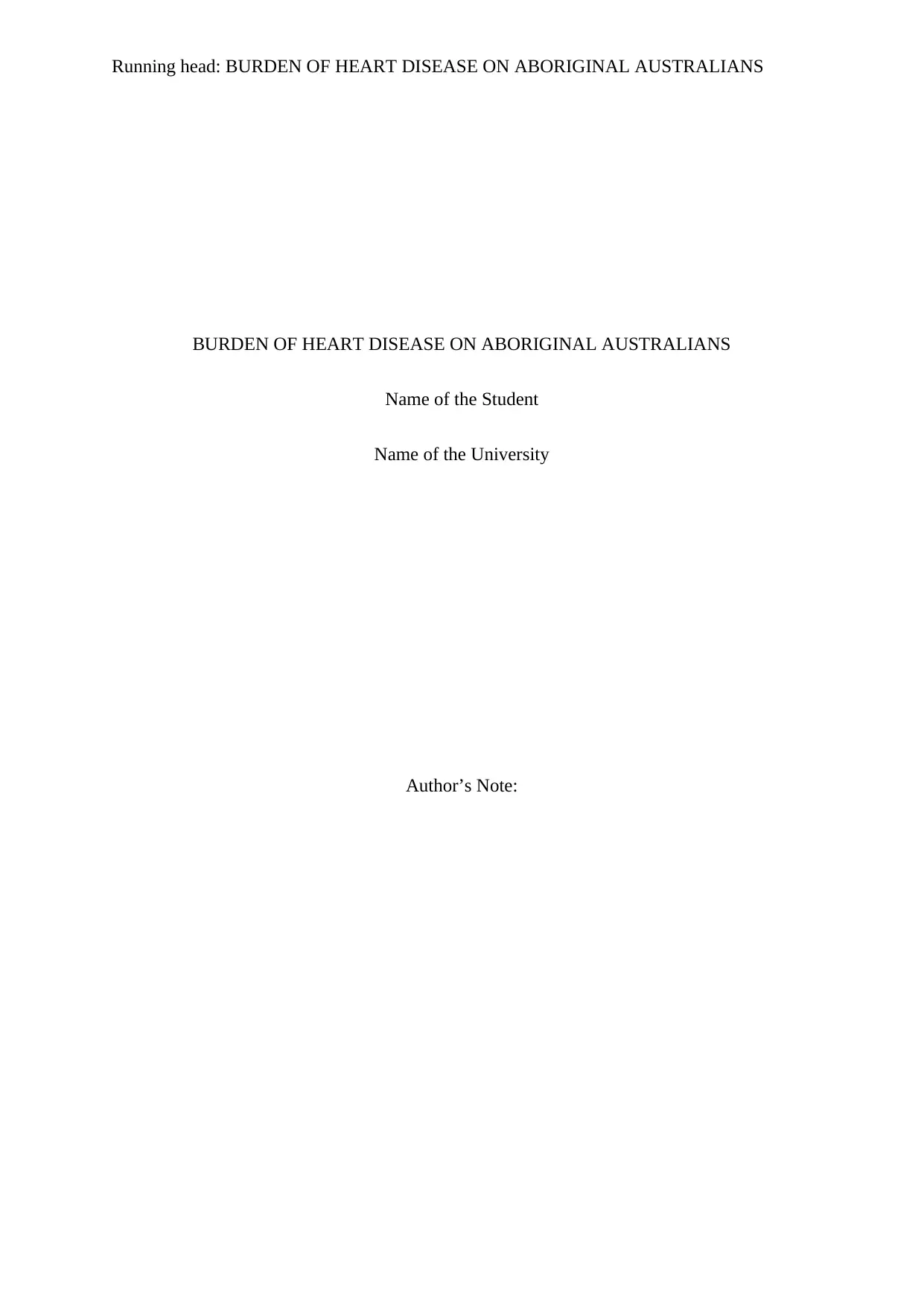
Running head: BURDEN OF HEART DISEASE ON ABORIGINAL AUSTRALIANS
BURDEN OF HEART DISEASE ON ABORIGINAL AUSTRALIANS
Name of the Student
Name of the University
Author’s Note:
BURDEN OF HEART DISEASE ON ABORIGINAL AUSTRALIANS
Name of the Student
Name of the University
Author’s Note:
Secure Best Marks with AI Grader
Need help grading? Try our AI Grader for instant feedback on your assignments.
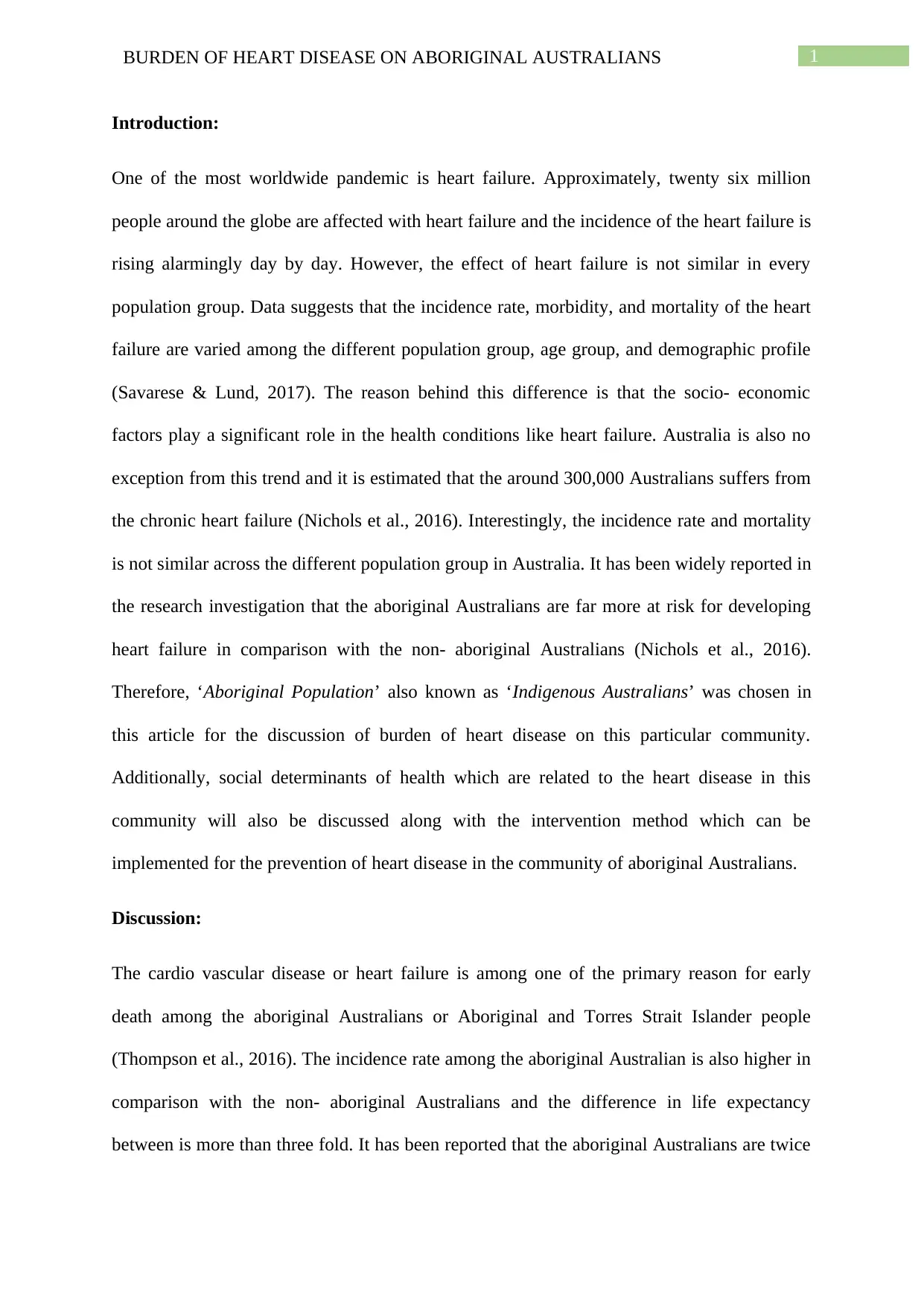
1BURDEN OF HEART DISEASE ON ABORIGINAL AUSTRALIANS
Introduction:
One of the most worldwide pandemic is heart failure. Approximately, twenty six million
people around the globe are affected with heart failure and the incidence of the heart failure is
rising alarmingly day by day. However, the effect of heart failure is not similar in every
population group. Data suggests that the incidence rate, morbidity, and mortality of the heart
failure are varied among the different population group, age group, and demographic profile
(Savarese & Lund, 2017). The reason behind this difference is that the socio- economic
factors play a significant role in the health conditions like heart failure. Australia is also no
exception from this trend and it is estimated that the around 300,000 Australians suffers from
the chronic heart failure (Nichols et al., 2016). Interestingly, the incidence rate and mortality
is not similar across the different population group in Australia. It has been widely reported in
the research investigation that the aboriginal Australians are far more at risk for developing
heart failure in comparison with the non- aboriginal Australians (Nichols et al., 2016).
Therefore, ‘Aboriginal Population’ also known as ‘Indigenous Australians’ was chosen in
this article for the discussion of burden of heart disease on this particular community.
Additionally, social determinants of health which are related to the heart disease in this
community will also be discussed along with the intervention method which can be
implemented for the prevention of heart disease in the community of aboriginal Australians.
Discussion:
The cardio vascular disease or heart failure is among one of the primary reason for early
death among the aboriginal Australians or Aboriginal and Torres Strait Islander people
(Thompson et al., 2016). The incidence rate among the aboriginal Australian is also higher in
comparison with the non- aboriginal Australians and the difference in life expectancy
between is more than three fold. It has been reported that the aboriginal Australians are twice
Introduction:
One of the most worldwide pandemic is heart failure. Approximately, twenty six million
people around the globe are affected with heart failure and the incidence of the heart failure is
rising alarmingly day by day. However, the effect of heart failure is not similar in every
population group. Data suggests that the incidence rate, morbidity, and mortality of the heart
failure are varied among the different population group, age group, and demographic profile
(Savarese & Lund, 2017). The reason behind this difference is that the socio- economic
factors play a significant role in the health conditions like heart failure. Australia is also no
exception from this trend and it is estimated that the around 300,000 Australians suffers from
the chronic heart failure (Nichols et al., 2016). Interestingly, the incidence rate and mortality
is not similar across the different population group in Australia. It has been widely reported in
the research investigation that the aboriginal Australians are far more at risk for developing
heart failure in comparison with the non- aboriginal Australians (Nichols et al., 2016).
Therefore, ‘Aboriginal Population’ also known as ‘Indigenous Australians’ was chosen in
this article for the discussion of burden of heart disease on this particular community.
Additionally, social determinants of health which are related to the heart disease in this
community will also be discussed along with the intervention method which can be
implemented for the prevention of heart disease in the community of aboriginal Australians.
Discussion:
The cardio vascular disease or heart failure is among one of the primary reason for early
death among the aboriginal Australians or Aboriginal and Torres Strait Islander people
(Thompson et al., 2016). The incidence rate among the aboriginal Australian is also higher in
comparison with the non- aboriginal Australians and the difference in life expectancy
between is more than three fold. It has been reported that the aboriginal Australians are twice
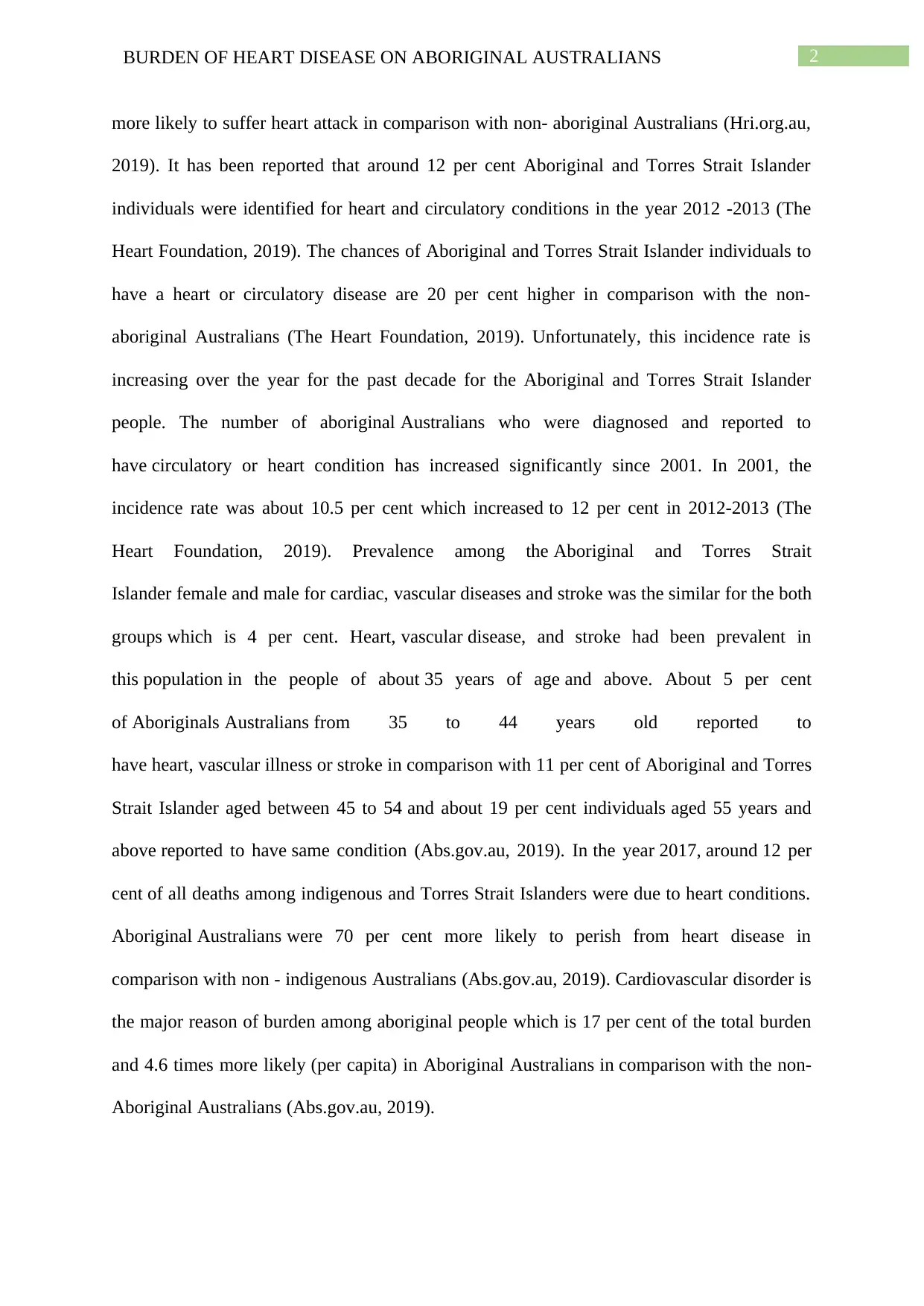
2BURDEN OF HEART DISEASE ON ABORIGINAL AUSTRALIANS
more likely to suffer heart attack in comparison with non- aboriginal Australians (Hri.org.au,
2019). It has been reported that around 12 per cent Aboriginal and Torres Strait Islander
individuals were identified for heart and circulatory conditions in the year 2012 -2013 (The
Heart Foundation, 2019). The chances of Aboriginal and Torres Strait Islander individuals to
have a heart or circulatory disease are 20 per cent higher in comparison with the non-
aboriginal Australians (The Heart Foundation, 2019). Unfortunately, this incidence rate is
increasing over the year for the past decade for the Aboriginal and Torres Strait Islander
people. The number of aboriginal Australians who were diagnosed and reported to
have circulatory or heart condition has increased significantly since 2001. In 2001, the
incidence rate was about 10.5 per cent which increased to 12 per cent in 2012-2013 (The
Heart Foundation, 2019). Prevalence among the Aboriginal and Torres Strait
Islander female and male for cardiac, vascular diseases and stroke was the similar for the both
groups which is 4 per cent. Heart, vascular disease, and stroke had been prevalent in
this population in the people of about 35 years of age and above. About 5 per cent
of Aboriginals Australians from 35 to 44 years old reported to
have heart, vascular illness or stroke in comparison with 11 per cent of Aboriginal and Torres
Strait Islander aged between 45 to 54 and about 19 per cent individuals aged 55 years and
above reported to have same condition (Abs.gov.au, 2019). In the year 2017, around 12 per
cent of all deaths among indigenous and Torres Strait Islanders were due to heart conditions.
Aboriginal Australians were 70 per cent more likely to perish from heart disease in
comparison with non - indigenous Australians (Abs.gov.au, 2019). Cardiovascular disorder is
the major reason of burden among aboriginal people which is 17 per cent of the total burden
and 4.6 times more likely (per capita) in Aboriginal Australians in comparison with the non-
Aboriginal Australians (Abs.gov.au, 2019).
more likely to suffer heart attack in comparison with non- aboriginal Australians (Hri.org.au,
2019). It has been reported that around 12 per cent Aboriginal and Torres Strait Islander
individuals were identified for heart and circulatory conditions in the year 2012 -2013 (The
Heart Foundation, 2019). The chances of Aboriginal and Torres Strait Islander individuals to
have a heart or circulatory disease are 20 per cent higher in comparison with the non-
aboriginal Australians (The Heart Foundation, 2019). Unfortunately, this incidence rate is
increasing over the year for the past decade for the Aboriginal and Torres Strait Islander
people. The number of aboriginal Australians who were diagnosed and reported to
have circulatory or heart condition has increased significantly since 2001. In 2001, the
incidence rate was about 10.5 per cent which increased to 12 per cent in 2012-2013 (The
Heart Foundation, 2019). Prevalence among the Aboriginal and Torres Strait
Islander female and male for cardiac, vascular diseases and stroke was the similar for the both
groups which is 4 per cent. Heart, vascular disease, and stroke had been prevalent in
this population in the people of about 35 years of age and above. About 5 per cent
of Aboriginals Australians from 35 to 44 years old reported to
have heart, vascular illness or stroke in comparison with 11 per cent of Aboriginal and Torres
Strait Islander aged between 45 to 54 and about 19 per cent individuals aged 55 years and
above reported to have same condition (Abs.gov.au, 2019). In the year 2017, around 12 per
cent of all deaths among indigenous and Torres Strait Islanders were due to heart conditions.
Aboriginal Australians were 70 per cent more likely to perish from heart disease in
comparison with non - indigenous Australians (Abs.gov.au, 2019). Cardiovascular disorder is
the major reason of burden among aboriginal people which is 17 per cent of the total burden
and 4.6 times more likely (per capita) in Aboriginal Australians in comparison with the non-
Aboriginal Australians (Abs.gov.au, 2019).
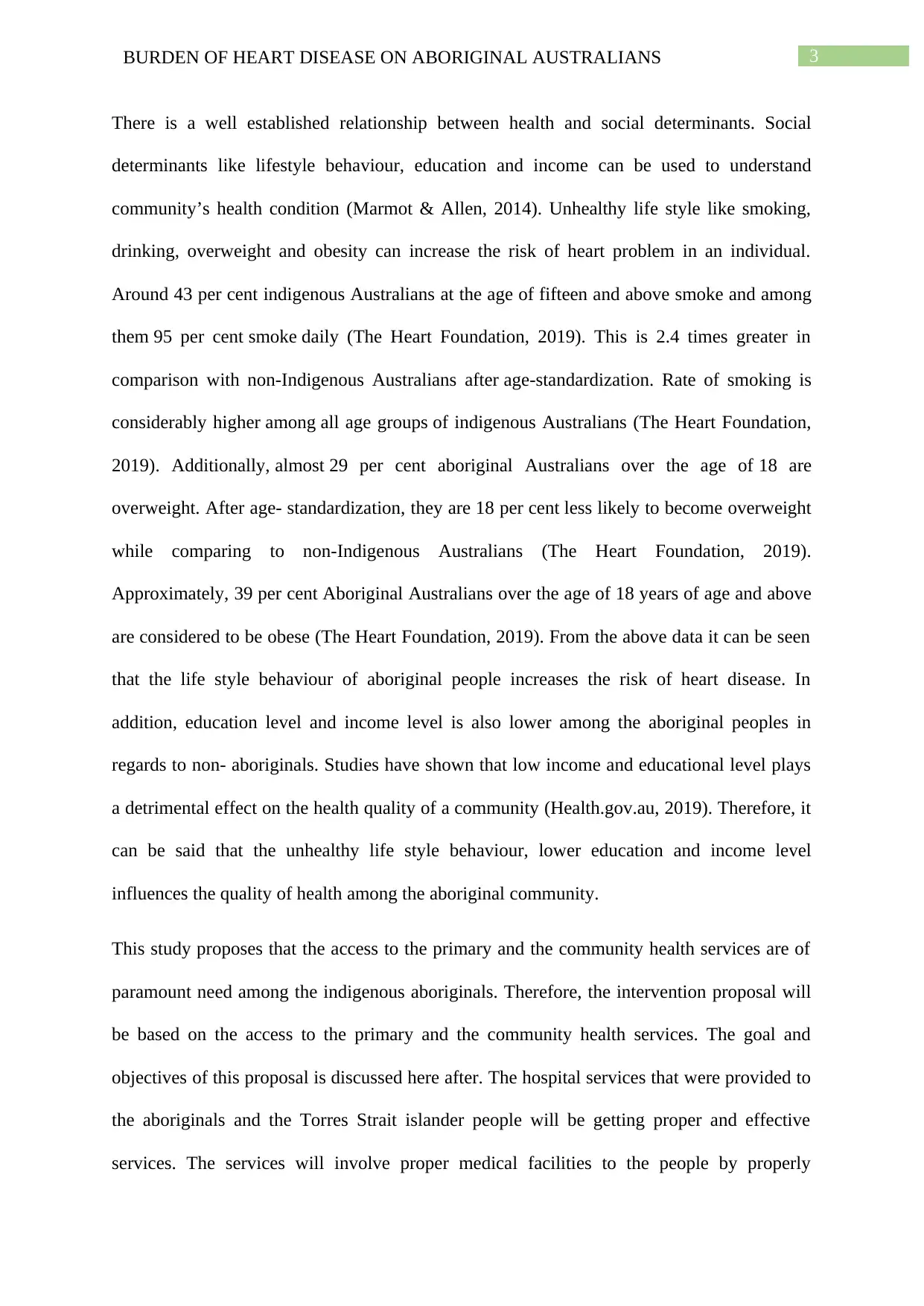
3BURDEN OF HEART DISEASE ON ABORIGINAL AUSTRALIANS
There is a well established relationship between health and social determinants. Social
determinants like lifestyle behaviour, education and income can be used to understand
community’s health condition (Marmot & Allen, 2014). Unhealthy life style like smoking,
drinking, overweight and obesity can increase the risk of heart problem in an individual.
Around 43 per cent indigenous Australians at the age of fifteen and above smoke and among
them 95 per cent smoke daily (The Heart Foundation, 2019). This is 2.4 times greater in
comparison with non-Indigenous Australians after age-standardization. Rate of smoking is
considerably higher among all age groups of indigenous Australians (The Heart Foundation,
2019). Additionally, almost 29 per cent aboriginal Australians over the age of 18 are
overweight. After age- standardization, they are 18 per cent less likely to become overweight
while comparing to non-Indigenous Australians (The Heart Foundation, 2019).
Approximately, 39 per cent Aboriginal Australians over the age of 18 years of age and above
are considered to be obese (The Heart Foundation, 2019). From the above data it can be seen
that the life style behaviour of aboriginal people increases the risk of heart disease. In
addition, education level and income level is also lower among the aboriginal peoples in
regards to non- aboriginals. Studies have shown that low income and educational level plays
a detrimental effect on the health quality of a community (Health.gov.au, 2019). Therefore, it
can be said that the unhealthy life style behaviour, lower education and income level
influences the quality of health among the aboriginal community.
This study proposes that the access to the primary and the community health services are of
paramount need among the indigenous aboriginals. Therefore, the intervention proposal will
be based on the access to the primary and the community health services. The goal and
objectives of this proposal is discussed here after. The hospital services that were provided to
the aboriginals and the Torres Strait islander people will be getting proper and effective
services. The services will involve proper medical facilities to the people by properly
There is a well established relationship between health and social determinants. Social
determinants like lifestyle behaviour, education and income can be used to understand
community’s health condition (Marmot & Allen, 2014). Unhealthy life style like smoking,
drinking, overweight and obesity can increase the risk of heart problem in an individual.
Around 43 per cent indigenous Australians at the age of fifteen and above smoke and among
them 95 per cent smoke daily (The Heart Foundation, 2019). This is 2.4 times greater in
comparison with non-Indigenous Australians after age-standardization. Rate of smoking is
considerably higher among all age groups of indigenous Australians (The Heart Foundation,
2019). Additionally, almost 29 per cent aboriginal Australians over the age of 18 are
overweight. After age- standardization, they are 18 per cent less likely to become overweight
while comparing to non-Indigenous Australians (The Heart Foundation, 2019).
Approximately, 39 per cent Aboriginal Australians over the age of 18 years of age and above
are considered to be obese (The Heart Foundation, 2019). From the above data it can be seen
that the life style behaviour of aboriginal people increases the risk of heart disease. In
addition, education level and income level is also lower among the aboriginal peoples in
regards to non- aboriginals. Studies have shown that low income and educational level plays
a detrimental effect on the health quality of a community (Health.gov.au, 2019). Therefore, it
can be said that the unhealthy life style behaviour, lower education and income level
influences the quality of health among the aboriginal community.
This study proposes that the access to the primary and the community health services are of
paramount need among the indigenous aboriginals. Therefore, the intervention proposal will
be based on the access to the primary and the community health services. The goal and
objectives of this proposal is discussed here after. The hospital services that were provided to
the aboriginals and the Torres Strait islander people will be getting proper and effective
services. The services will involve proper medical facilities to the people by properly
Secure Best Marks with AI Grader
Need help grading? Try our AI Grader for instant feedback on your assignments.
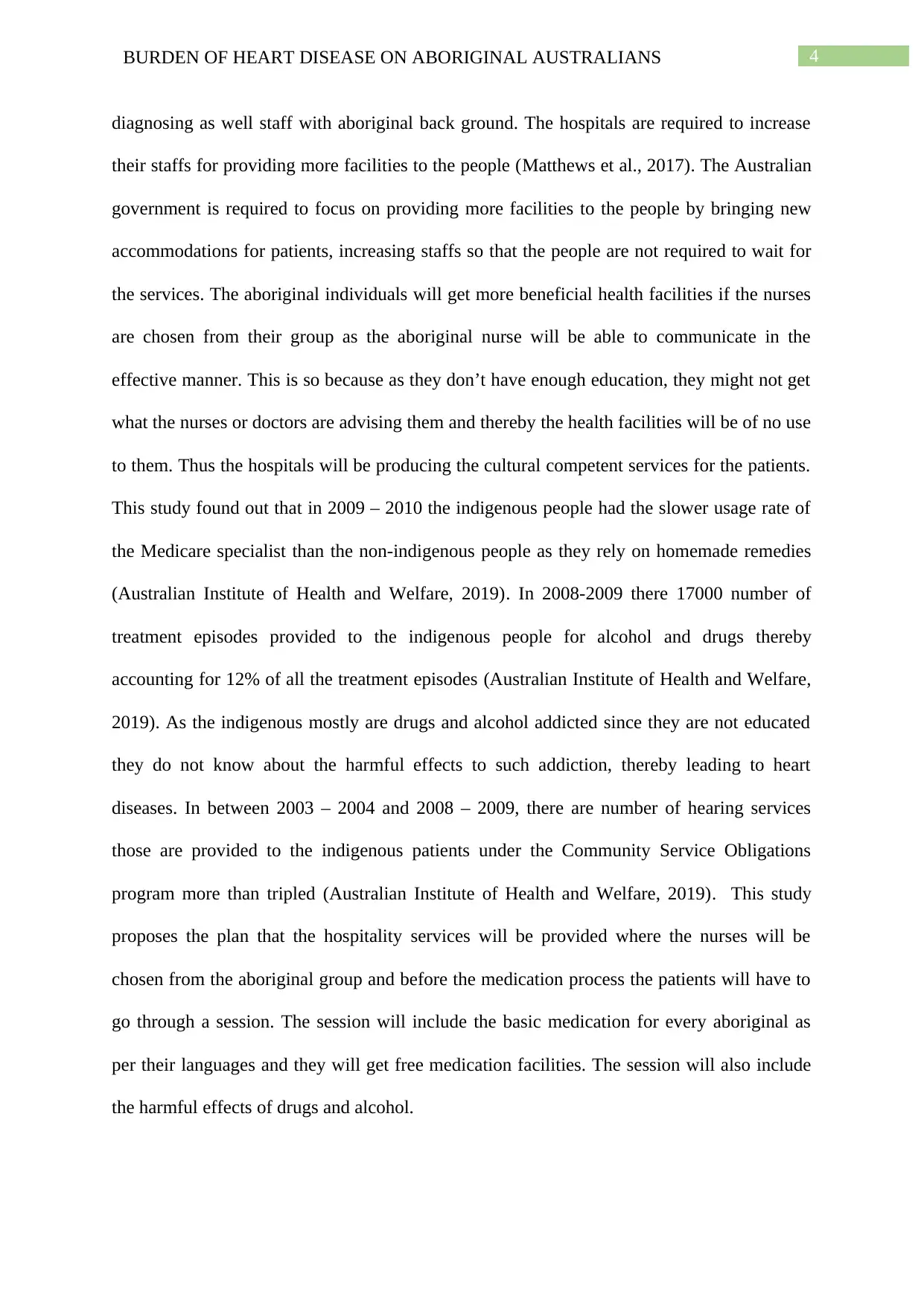
4BURDEN OF HEART DISEASE ON ABORIGINAL AUSTRALIANS
diagnosing as well staff with aboriginal back ground. The hospitals are required to increase
their staffs for providing more facilities to the people (Matthews et al., 2017). The Australian
government is required to focus on providing more facilities to the people by bringing new
accommodations for patients, increasing staffs so that the people are not required to wait for
the services. The aboriginal individuals will get more beneficial health facilities if the nurses
are chosen from their group as the aboriginal nurse will be able to communicate in the
effective manner. This is so because as they don’t have enough education, they might not get
what the nurses or doctors are advising them and thereby the health facilities will be of no use
to them. Thus the hospitals will be producing the cultural competent services for the patients.
This study found out that in 2009 – 2010 the indigenous people had the slower usage rate of
the Medicare specialist than the non-indigenous people as they rely on homemade remedies
(Australian Institute of Health and Welfare, 2019). In 2008-2009 there 17000 number of
treatment episodes provided to the indigenous people for alcohol and drugs thereby
accounting for 12% of all the treatment episodes (Australian Institute of Health and Welfare,
2019). As the indigenous mostly are drugs and alcohol addicted since they are not educated
they do not know about the harmful effects to such addiction, thereby leading to heart
diseases. In between 2003 – 2004 and 2008 – 2009, there are number of hearing services
those are provided to the indigenous patients under the Community Service Obligations
program more than tripled (Australian Institute of Health and Welfare, 2019). This study
proposes the plan that the hospitality services will be provided where the nurses will be
chosen from the aboriginal group and before the medication process the patients will have to
go through a session. The session will include the basic medication for every aboriginal as
per their languages and they will get free medication facilities. The session will also include
the harmful effects of drugs and alcohol.
diagnosing as well staff with aboriginal back ground. The hospitals are required to increase
their staffs for providing more facilities to the people (Matthews et al., 2017). The Australian
government is required to focus on providing more facilities to the people by bringing new
accommodations for patients, increasing staffs so that the people are not required to wait for
the services. The aboriginal individuals will get more beneficial health facilities if the nurses
are chosen from their group as the aboriginal nurse will be able to communicate in the
effective manner. This is so because as they don’t have enough education, they might not get
what the nurses or doctors are advising them and thereby the health facilities will be of no use
to them. Thus the hospitals will be producing the cultural competent services for the patients.
This study found out that in 2009 – 2010 the indigenous people had the slower usage rate of
the Medicare specialist than the non-indigenous people as they rely on homemade remedies
(Australian Institute of Health and Welfare, 2019). In 2008-2009 there 17000 number of
treatment episodes provided to the indigenous people for alcohol and drugs thereby
accounting for 12% of all the treatment episodes (Australian Institute of Health and Welfare,
2019). As the indigenous mostly are drugs and alcohol addicted since they are not educated
they do not know about the harmful effects to such addiction, thereby leading to heart
diseases. In between 2003 – 2004 and 2008 – 2009, there are number of hearing services
those are provided to the indigenous patients under the Community Service Obligations
program more than tripled (Australian Institute of Health and Welfare, 2019). This study
proposes the plan that the hospitality services will be provided where the nurses will be
chosen from the aboriginal group and before the medication process the patients will have to
go through a session. The session will include the basic medication for every aboriginal as
per their languages and they will get free medication facilities. The session will also include
the harmful effects of drugs and alcohol.
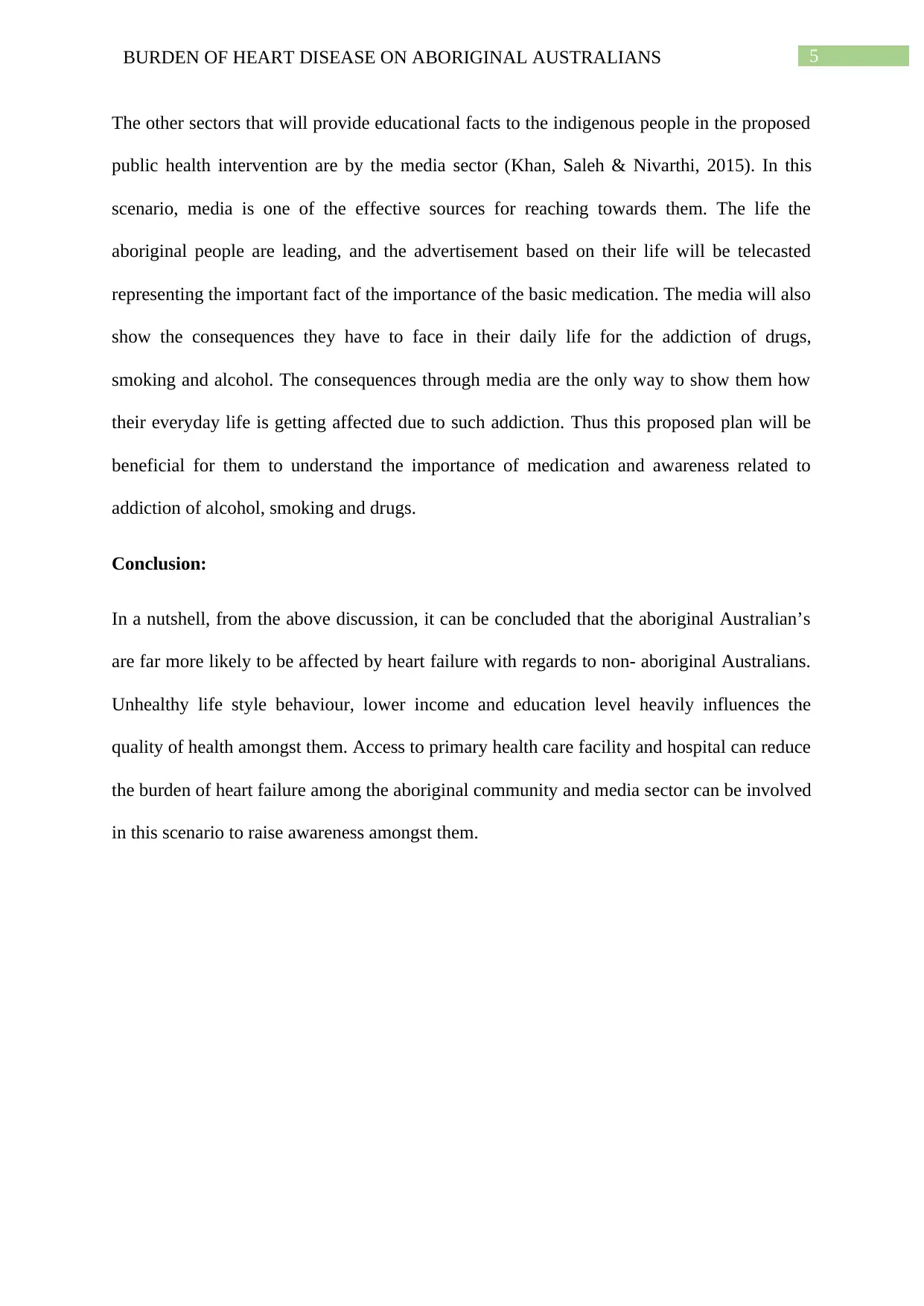
5BURDEN OF HEART DISEASE ON ABORIGINAL AUSTRALIANS
The other sectors that will provide educational facts to the indigenous people in the proposed
public health intervention are by the media sector (Khan, Saleh & Nivarthi, 2015). In this
scenario, media is one of the effective sources for reaching towards them. The life the
aboriginal people are leading, and the advertisement based on their life will be telecasted
representing the important fact of the importance of the basic medication. The media will also
show the consequences they have to face in their daily life for the addiction of drugs,
smoking and alcohol. The consequences through media are the only way to show them how
their everyday life is getting affected due to such addiction. Thus this proposed plan will be
beneficial for them to understand the importance of medication and awareness related to
addiction of alcohol, smoking and drugs.
Conclusion:
In a nutshell, from the above discussion, it can be concluded that the aboriginal Australian’s
are far more likely to be affected by heart failure with regards to non- aboriginal Australians.
Unhealthy life style behaviour, lower income and education level heavily influences the
quality of health amongst them. Access to primary health care facility and hospital can reduce
the burden of heart failure among the aboriginal community and media sector can be involved
in this scenario to raise awareness amongst them.
The other sectors that will provide educational facts to the indigenous people in the proposed
public health intervention are by the media sector (Khan, Saleh & Nivarthi, 2015). In this
scenario, media is one of the effective sources for reaching towards them. The life the
aboriginal people are leading, and the advertisement based on their life will be telecasted
representing the important fact of the importance of the basic medication. The media will also
show the consequences they have to face in their daily life for the addiction of drugs,
smoking and alcohol. The consequences through media are the only way to show them how
their everyday life is getting affected due to such addiction. Thus this proposed plan will be
beneficial for them to understand the importance of medication and awareness related to
addiction of alcohol, smoking and drugs.
Conclusion:
In a nutshell, from the above discussion, it can be concluded that the aboriginal Australian’s
are far more likely to be affected by heart failure with regards to non- aboriginal Australians.
Unhealthy life style behaviour, lower income and education level heavily influences the
quality of health amongst them. Access to primary health care facility and hospital can reduce
the burden of heart failure among the aboriginal community and media sector can be involved
in this scenario to raise awareness amongst them.
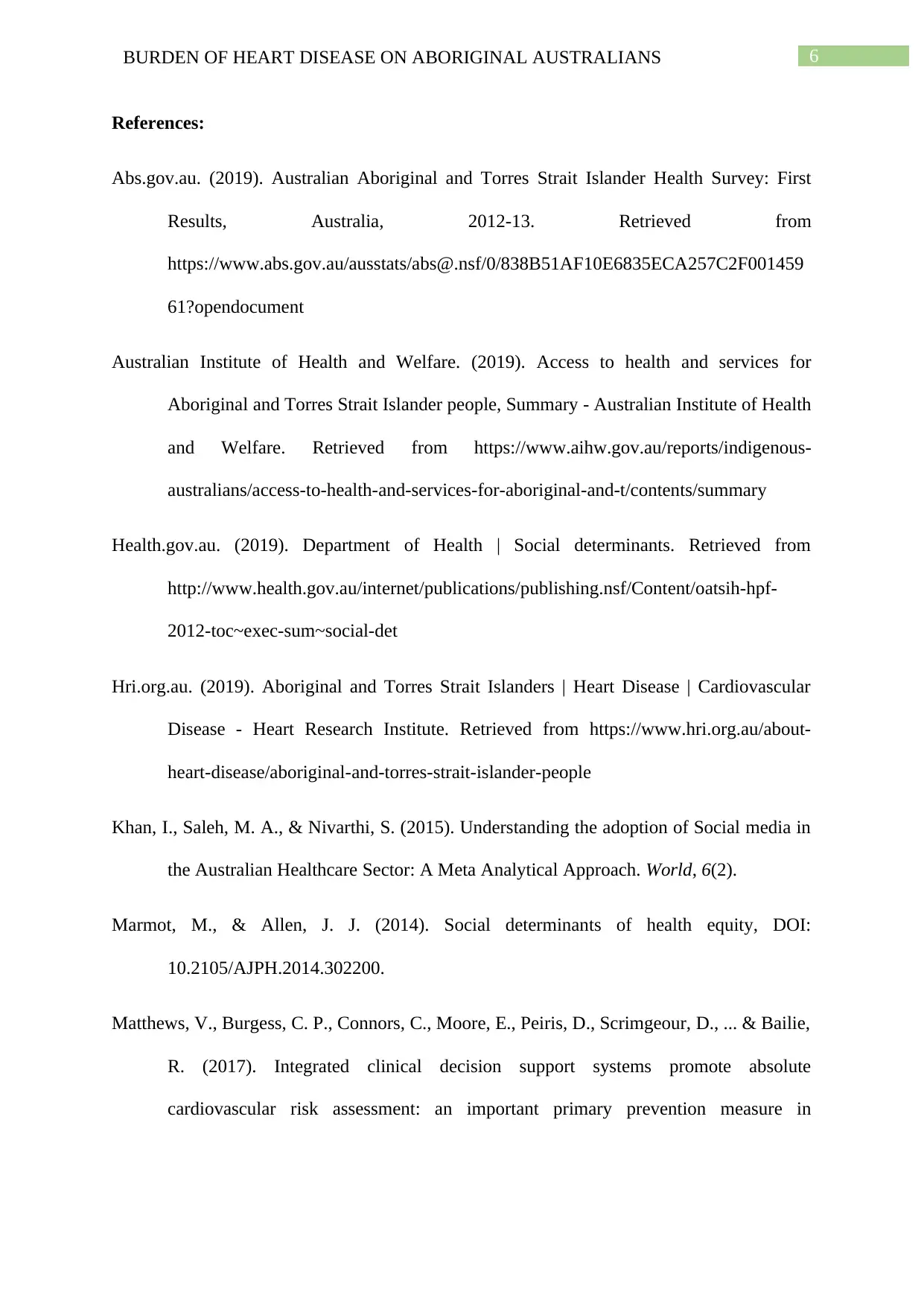
6BURDEN OF HEART DISEASE ON ABORIGINAL AUSTRALIANS
References:
Abs.gov.au. (2019). Australian Aboriginal and Torres Strait Islander Health Survey: First
Results, Australia, 2012-13. Retrieved from
https://www.abs.gov.au/ausstats/abs@.nsf/0/838B51AF10E6835ECA257C2F001459
61?opendocument
Australian Institute of Health and Welfare. (2019). Access to health and services for
Aboriginal and Torres Strait Islander people, Summary - Australian Institute of Health
and Welfare. Retrieved from https://www.aihw.gov.au/reports/indigenous-
australians/access-to-health-and-services-for-aboriginal-and-t/contents/summary
Health.gov.au. (2019). Department of Health | Social determinants. Retrieved from
http://www.health.gov.au/internet/publications/publishing.nsf/Content/oatsih-hpf-
2012-toc~exec-sum~social-det
Hri.org.au. (2019). Aboriginal and Torres Strait Islanders | Heart Disease | Cardiovascular
Disease - Heart Research Institute. Retrieved from https://www.hri.org.au/about-
heart-disease/aboriginal-and-torres-strait-islander-people
Khan, I., Saleh, M. A., & Nivarthi, S. (2015). Understanding the adoption of Social media in
the Australian Healthcare Sector: A Meta Analytical Approach. World, 6(2).
Marmot, M., & Allen, J. J. (2014). Social determinants of health equity, DOI:
10.2105/AJPH.2014.302200.
Matthews, V., Burgess, C. P., Connors, C., Moore, E., Peiris, D., Scrimgeour, D., ... & Bailie,
R. (2017). Integrated clinical decision support systems promote absolute
cardiovascular risk assessment: an important primary prevention measure in
References:
Abs.gov.au. (2019). Australian Aboriginal and Torres Strait Islander Health Survey: First
Results, Australia, 2012-13. Retrieved from
https://www.abs.gov.au/ausstats/abs@.nsf/0/838B51AF10E6835ECA257C2F001459
61?opendocument
Australian Institute of Health and Welfare. (2019). Access to health and services for
Aboriginal and Torres Strait Islander people, Summary - Australian Institute of Health
and Welfare. Retrieved from https://www.aihw.gov.au/reports/indigenous-
australians/access-to-health-and-services-for-aboriginal-and-t/contents/summary
Health.gov.au. (2019). Department of Health | Social determinants. Retrieved from
http://www.health.gov.au/internet/publications/publishing.nsf/Content/oatsih-hpf-
2012-toc~exec-sum~social-det
Hri.org.au. (2019). Aboriginal and Torres Strait Islanders | Heart Disease | Cardiovascular
Disease - Heart Research Institute. Retrieved from https://www.hri.org.au/about-
heart-disease/aboriginal-and-torres-strait-islander-people
Khan, I., Saleh, M. A., & Nivarthi, S. (2015). Understanding the adoption of Social media in
the Australian Healthcare Sector: A Meta Analytical Approach. World, 6(2).
Marmot, M., & Allen, J. J. (2014). Social determinants of health equity, DOI:
10.2105/AJPH.2014.302200.
Matthews, V., Burgess, C. P., Connors, C., Moore, E., Peiris, D., Scrimgeour, D., ... & Bailie,
R. (2017). Integrated clinical decision support systems promote absolute
cardiovascular risk assessment: an important primary prevention measure in
Paraphrase This Document
Need a fresh take? Get an instant paraphrase of this document with our AI Paraphraser
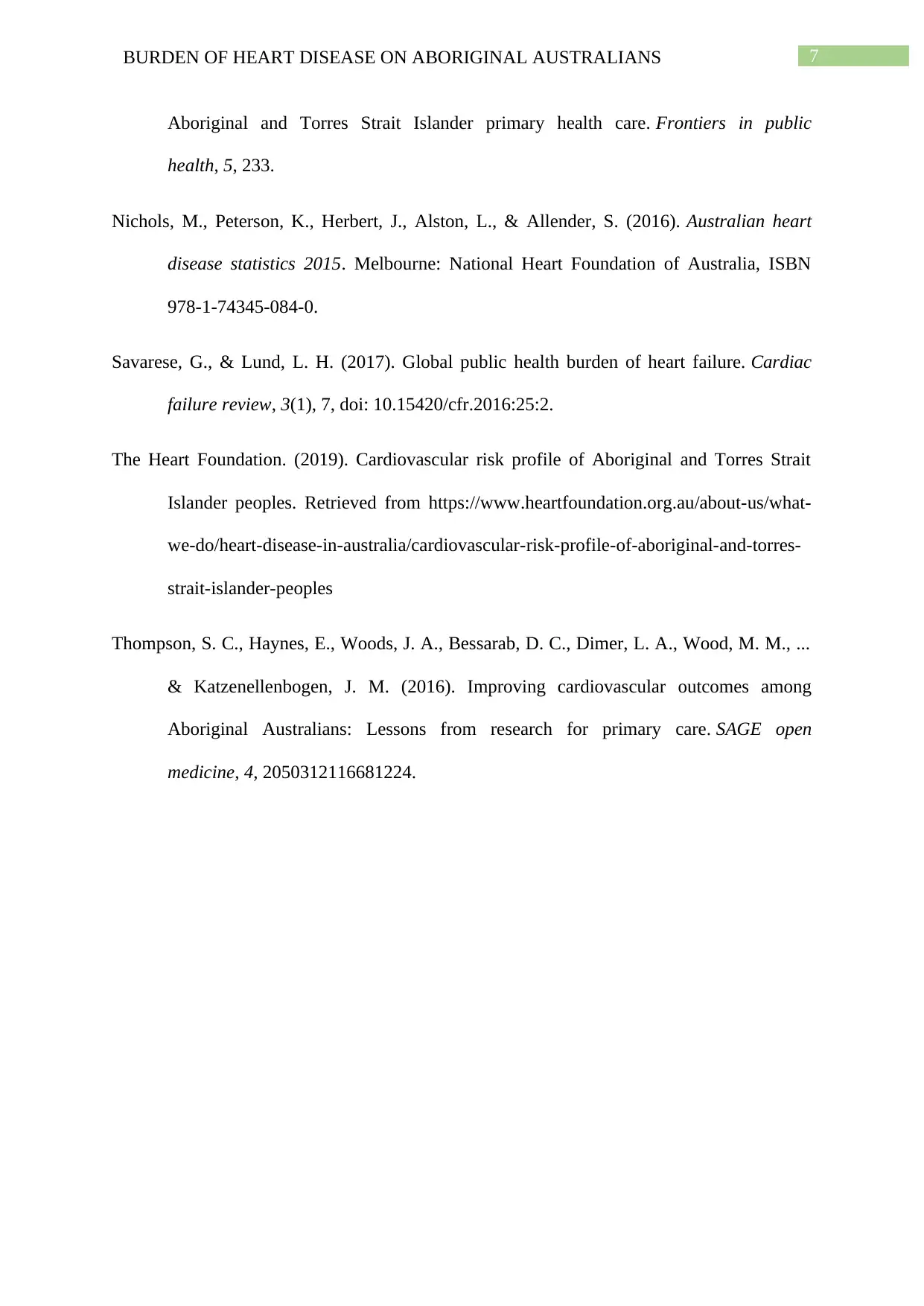
7BURDEN OF HEART DISEASE ON ABORIGINAL AUSTRALIANS
Aboriginal and Torres Strait Islander primary health care. Frontiers in public
health, 5, 233.
Nichols, M., Peterson, K., Herbert, J., Alston, L., & Allender, S. (2016). Australian heart
disease statistics 2015. Melbourne: National Heart Foundation of Australia, ISBN
978-1-74345-084-0.
Savarese, G., & Lund, L. H. (2017). Global public health burden of heart failure. Cardiac
failure review, 3(1), 7, doi: 10.15420/cfr.2016:25:2.
The Heart Foundation. (2019). Cardiovascular risk profile of Aboriginal and Torres Strait
Islander peoples. Retrieved from https://www.heartfoundation.org.au/about-us/what-
we-do/heart-disease-in-australia/cardiovascular-risk-profile-of-aboriginal-and-torres-
strait-islander-peoples
Thompson, S. C., Haynes, E., Woods, J. A., Bessarab, D. C., Dimer, L. A., Wood, M. M., ...
& Katzenellenbogen, J. M. (2016). Improving cardiovascular outcomes among
Aboriginal Australians: Lessons from research for primary care. SAGE open
medicine, 4, 2050312116681224.
Aboriginal and Torres Strait Islander primary health care. Frontiers in public
health, 5, 233.
Nichols, M., Peterson, K., Herbert, J., Alston, L., & Allender, S. (2016). Australian heart
disease statistics 2015. Melbourne: National Heart Foundation of Australia, ISBN
978-1-74345-084-0.
Savarese, G., & Lund, L. H. (2017). Global public health burden of heart failure. Cardiac
failure review, 3(1), 7, doi: 10.15420/cfr.2016:25:2.
The Heart Foundation. (2019). Cardiovascular risk profile of Aboriginal and Torres Strait
Islander peoples. Retrieved from https://www.heartfoundation.org.au/about-us/what-
we-do/heart-disease-in-australia/cardiovascular-risk-profile-of-aboriginal-and-torres-
strait-islander-peoples
Thompson, S. C., Haynes, E., Woods, J. A., Bessarab, D. C., Dimer, L. A., Wood, M. M., ...
& Katzenellenbogen, J. M. (2016). Improving cardiovascular outcomes among
Aboriginal Australians: Lessons from research for primary care. SAGE open
medicine, 4, 2050312116681224.
1 out of 8
Related Documents
Your All-in-One AI-Powered Toolkit for Academic Success.
+13062052269
info@desklib.com
Available 24*7 on WhatsApp / Email
![[object Object]](/_next/static/media/star-bottom.7253800d.svg)
Unlock your academic potential
© 2024 | Zucol Services PVT LTD | All rights reserved.





